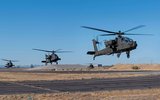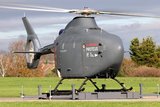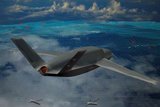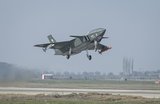Rostec reveals new alpine helicopter
Kamov’s Ka-226 is a further development of the company’s Ka-26 line of utility helicopters. (Photo: Rostec)
Russian Helicopters, a subsidiary of Rostec State Corporation, has unveiled its newest modification of the light Ka-226T helicopter.
A key feature of the new modified helicopter is its ease of flight in high mountains regions, hence its working name ‘Alpinist’ (Climber).
The aircraft has coaxial rotors, which ensures good control at the most extreme heights and in rarefied air, crosswind stability, high rate of climb and the possibility of taking off and landing on sites located very high.
It is also capable of taking off and landing on the deck of even small vessels.
The helicopter has a new glider-like design with considerably better aerodynamics. It will be able to fly for longer, have a lower weight and will be capable of operation at heights of up to 6,500 meters.
The fuselage is made of modern light materials, the control system and power system of the helicopter have been upgraded and a shock- and crash-resistant fuel system is installed.
Test flights will commence in autumn and serial production is expected to start in 2022.
According to Shephard Defence Insight, in 2020 Rosoboronexport announced that it had created a joint Russian-Indian enterprise for the production of Ka-226T.
Related Equipment in Defence Insight
More from Air Warfare
-
![Leonardo’s Proteus concludes ground tests with maiden flight on horizon]()
Leonardo’s Proteus concludes ground tests with maiden flight on horizon
The technology demonstrator forms part of a wider effort to help the Royal Navy explore the potential of uncrewed systems supporting its existing crewed aviation platforms.
-
![Airbus MQ-72C Lakota Connector progress on track ahead of pending USMC decision]()
Airbus MQ-72C Lakota Connector progress on track ahead of pending USMC decision
The MQ-7C uncrewed aircraft is currently undergoing further internal flight tests ahead of a government test event anticipated for next year.
-
![November Drone Digest: GA-ASI eyes Middle East for Gambit, Edge Group unveils new UAVs]()
November Drone Digest: GA-ASI eyes Middle East for Gambit, Edge Group unveils new UAVs
In November 2025, GA-ASI unveiled a new Gambit variant, the Gambit 6, and appears to be pitching the aircraft series to various customers in the Middle East, which is a fast-emerging CCA market. The Dubai Airshow also saw the unveiling of various Emirati aircraft from Edge Group.
-
![Baykar’s Kizilelma drone makes progress with first air-to-air kill]()
Baykar’s Kizilelma drone makes progress with first air-to-air kill
This test is the latest milestone achieved by the indigenous drone, destroying a target using a beyond-visual-range missile.
-
![Lockheed plans further solid rocket motor investment in Europe and Middle East]()
Lockheed plans further solid rocket motor investment in Europe and Middle East
The company has worked to heavily invest in its solid rocket motor production capabilities, both in the US and internationally, to build a strong supply chain to meet growing demand.
























